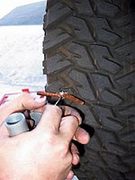Some More
Fix it
What Are Spark Plugs?
Your engine burns gasoline in order to generate power. It sucks in air through the air intake, and it sucks in gasoline through the fuel line from the gas tank. It puts both of these into a hollowed out cylinder in the engine. A piston comes up and squeezes the air and gasoline mixture, compressing it. Then, at just the right moment, the computer tells the spark plug, which is sticking into the cylinder, to fire a spark. When it does, this ignites the gasoline and air, and the mixture explodes. This pushes the piston down. The piston is connected to a big bar called a crank shaft, so when it is pushed down, it makes the shaft turn. This turning is sent out the back of the engine to the transmission, and from there to the transfer case, and from there to the drive shafts.
Spark plugs are the things that stick in the cylinders which fire a spark to burn gasoline.
Why Do I Need to Change My Spark Plugs?
Because as they are used, the metal ends that the spark jumps from are burned. The more they are used, the more this area burns, until finally it no longer makes a good spark for the engine to run smoothly. Sometimes it sparks, and sometimes it pukes out. So, every 30,000 miles, it's a great idea to pull those things out and put in new ones.
Change your spark plugs
Bolt Size & Torque Specifications
1. Loosen the screw on the silver band around the air tube connection to the air box and remove the tube.
2. Move the air tube out of your way so you can reach the bolts holding in the coil rail.
3. Remove the four bolts holding in the coil rail and store them away somewhere safe.
4. Remove that annoying zip tie I mentioned before if it looks like it will give you trouble.
5. Pull the coil rail off of the spark plugs. The rail has rubber boots on the other side, tubes that go over the ends of the spark plugs to give them electricity from the battery. Try to move the coil rail out of your way without screwing up the cables or sitting it on the battery. Don't touch the battery poles or any red wire ends under the hood.
6. Place the spark plug socket over a spark plug, put an extender in it, hook up your breaker bar, and start turning it out of there. Keep the socket seated all the way down to the engine block or the plug will just break and get ceramic everywhere. Keep the extender and the socket straight up and down in line with the angle of the spark plug while turning, also.
7. Spread anti-seize on the threads. Just enough to cover them good. Even if your plugs say they are pre-coated, do this step anyway, or you'll be cussing some serious profanity when you try to get them out in 30,000 miles.
8. Screw in the spark plug by hand. Be careful not to force it to go in unnaturally, or you will end up cross-threading your engine threads, and then you won't be able to get anything to screw into them again until a professional fixes them for you... or you get a new engine. Be careful, thread them in correctly and straight.
9. Repeat this process for the next five spark plugs. Spray air to clean around the plug, pull it out, grease the threads on one, and stick it in. You will have to get creative as you work your way back to the last one using extenders and wobble sockets to pull them out.
Plug your Tire
WINTER READY!!
Maintenance (What to do before it's cold)
1. Make sure your cooling system is in good shape. If you are in doubt about the mixture of antifreeze to water in it, drain the liquid and replace it. Also, if the coolant has been in there more than a year, drain and replace it too. Believe it or not, snow driving is hard on the cooling system, and you want everything working in top form. Between higher rpm, higher engine loads, and the occasional snow jammed in the radiator, the system has its work cut out.
2. Check hoses while you are messing with the cooling system. Check them for bulges, cracks, or anything out of the ordinary. If there is any doubt, replace them. Heat-cycling in the cold is rough on rubber, and if your stuff is worn then it's that much more likely to burst.
3. Get under the Jeep and grease everything with a zerk fitting.
4. Check driveshafts for play. Do this while the Jeep is out of gear with the wheels chocked on level ground. If any of your U-joints are going bad or seem questionable, replace them.
5. Check your accessory drsilicone-based spray. If rain, sleet, or snow finds its way to your seals and then freezes overnight, you'll have problems getting into your Jeep or, in some cases, be locked out entirely.
6. If you drove your Jeep during the spring or summer, check your axles, transmission, and transfer case for water. Just look for chocolate or strawberry milk shakes, especially if you've done any stream, river, or pond crossings, you should replace those fluids.
7. If you swap to winter tires, now is the time to do it. If not, check tires for wear, dry rotting, and tread depth. Anything under 11/44-inch is dangerous in the winter and should be replaced.
8. Lubricate all door and tailgate locks with a good graphite lock lubricant, not WD-40 or anything else oil-based. The inside of the locks will attract dirt, which will attract moisture, which freezes.
10. Check clutch and brake fluids. If they are really dirty, it means there is a lot of moisture in them. Have them power bled or get a friend to help. Get new, clean, moisture-free DOT 3 or DOT 4 fluid in there.
11. Brake pads and shoes. Now is the time to make sure they are OK. Don't wait until after the first blizzard to check.
12. Emergency/parking brake: Make sure the cables are OK (no rust, fraying, or anything), and the system works as it's supposed to.
13. Any electrical connections that are subject to the weather - such as headlights, turn signals, stoplights, winch cable controller, electric fan connectors, and the like - should get some dielectric grease applied to them. If they use road salt where you are or where you go, the connections will corrode much faster in the winter and, in some cases, cause other problems.
14. If it gets really cold where you live or you drive in really sloppy conditions, get some of the "winter" windshield washer fluid. Drain your washer reservoir either through use or other means and run your washer pump for 10-15 seconds to get the summer swamp water (or whatever was in there) out of the lines from that last mudding trip.
15. Vent lines are easy to forget in the winter. But once you get done driving down the highway to the trail and you start plowing your axles through the snow, the vent lines will rip out if they aren't attached firmly. If they aren't in good shape or attached at all, the melting snow will find its way in as the hot axle cools. Granted, snow alone probably won't hurt, but one dunk in that frozen lake or ice-water stream could mean a world of hurt for your expensive gears and lockers.

